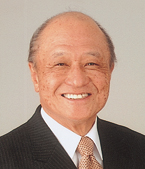
Mr. Takashi Onisi was born in Ise-shi, Mie Prefecture, in July, 1933. “My father, Shinpei Onisi, was engaged in the wholesaling of sundries and cosmetics. After the lifting of war-time regulations on textile goods, my father went to Osaka and started as a textile wholesaler. I was just graduating from junior high school then and went to Tennoji Commercial High School, following my father’s command 'to go to school in Osaka.' Since I was set on succeeding the family business, I had no objection to coming to Osaka. After graduating from high school I joined Onisi Iryo, my father’s textile wholesale company. Of three stores in the textile district of Umeda, I was put in charge of the smallest of them, Marukichi. There was a head clerk but I was doing everything in the store, though I was yet to be 20 years old.”
“One day a knit-wear maker in Izumi-Ohtsu brought his samples to our store and asked me to handle his goods. He was a sincere person who quit teaching to help his family business. I made an immediate decision and told him 'I will buy everything you make.' But his shipments started to came in every day and our small store overflowed with them. In the end, we had to ask one of our customers, Miyako Seni in Tokyo, to take them over. From then on, while I was helping my father, I was doing the buying for Miyako Seni and sent Miyako Seni the merchandise I bought from textile manufacturers around Osaka. Miyako Seni sold in small quantities and in cash. Because I told my father how prosperous it was, he became interested in cash-and-carry wholesaling.”
“But when we started a cash-and-carry store in March, 1954, it did not sell at all and was in the red. We lost patience and went to consult with the president of Miyako Seni. He advised us ‘Be patient a little longer. July is the key month for summer goods.’ As he advised, our sales suddenly jumped up in July. At that time we set our basic objectives for cash-and-carry wholesaling as: 5% gross margins, 3% expenses, 2% profits, of which 1% goes to taxes, and 1% profits after tax.” |
Mr. Shinpei Onisi went to see America in 1957 and started the foreign trade department with Mr. Takashi Onisi as its head. Mr. Onisi (junior) says “Another turning point in our business was triggered by my first trip to the US in 1959.”
“I participated in a seminar for cash register users in Ohio. We had lectures in the morning and went to see supermarkets in the afternoon. In those days, department stores were only large-scale stores in Japan. Self-service systems, in which customers picked up goods of their liking, put them in a basket and paid at the cash register, were very attractive to us because of the principle that, by using them, we could reduce personnel expenses for clerks and offer goods at lower prices.” |
Since then Mr. Takashi Onisi has expanded the company’s businesses. Besides Onisi Iryo, the company has operated and/or is operating Self International with production capabilities, Self Tenken that handles store interiors and fixtures, Beallen that is a retailer of ladies clothing, Valeur that supports retailers’ mail-order business, Family-Joy that offers retailers automatic merchandise replenishment services using the internet, and Driver Stand, an automotive goods chain.
In the 1990’s the apparel industry in Japan underwent drastic changes caused by the rapid increase in low-priced Chinese imports. In this context Onisi Iryo experienced a steady decline in its sales and kept Mr. Takashi Onisi searching for new business models. |